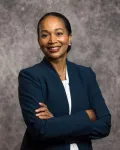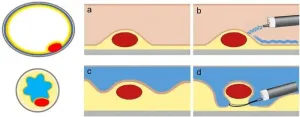(Press-News.org) Leuven/Amsterdam/Cambridge, 5 September– A team of researchers at the VIB-KU Leuven Center for Cancer Biology, the Netherlands Cancer Institute and Oncode Institute and the University of Cambridge have discovered that a defensive mechanism connected to the menstrual cycle plays a role in spreading mutant cells within mammary tissue. A new study published in Nature describes how the growth and subsequent removal of extra milk ducts in breast tissue during the menstrual cycle can contribute to the spread of mutant cells leading to large mutant fields prone to develop tumors.
Although tissue in healthy individuals may look completely normal, it can contain large fields of mutant cells that are capable of growing into a tumor. The more cells within a normal looking, but mutant field, the higher the chance that one of these cells will behave abnormally and develop into cancer. To date, researchers are unsure of how these large fields of mutant cells develop in normal tissue.
Some theories propose that mutant cells spreading over large fields of tissue may play a crucial role in the initiation and recurrence of human breast cancer. An international team of researchers led by Professors Colinda Scheele at the VIB-KU Leuven Center for Cancer Biology, Jacco van Rheenen at the Netherlands Cancer Institute and Oncode Institute, from Cancer Grand Challenges team PRECISION, funded by Cancer Research UK and KWF Dutch Cancer Society, and Benjamin Simons at the University of Cambridge has now published new findings suggesting that a mechanism responsible for normal remodeling of breast tissue during the menstrual cycle is a potential driver of breast cancer development.
When remodeling does not go to plan
During the equivalent of the menstrual cycle in mice, the mammary glands go on a remodeling spree. Heightened estrogen levels ensure the creation of small alveoli that grow into milk-producing units upon pregnancy. However, when there is no pregnancy, the body recognizes that these alveoli serve no purpose. At the end of the cycle, the body therefore breaks down these milk ducts removing most of the expanded cells.
Even though this mechanism seems to be very effective at cleaning out excess cells, including mutant cells, it appears it is not infallible. The body cleans up most of these cells at the end of the cycle but some mutant cells, by chance, may survive this process. Instead, the tissue remodeling now allows these cells to proliferate and spread within the normal tissue. Thus, the natural tissue remodeling in the breast appears to be a double-edged sword: on the one hand it leads to the natural removal of excess (both normal and mutant) cells, on the other hand it facilitates the expansion of a few mutant cells within the healthy tissue.
Colinda Scheele: “In our study, we observed the evolution of mutant cells before they developed into cancer. More specifically, we labelled both healthy and mutated stem cells in the mammary tissue of mice and tracked their behavior over several months. Our findings showed that the menstrual cycle influenced the behavior of the labelled cells and allowed some of them to spread over large distances. "
Jacco Van Rheenen: “Our findings demonstrate that with each menstrual cycle, there is a slight chance that mutated clones can become larger and spread over large areas within the breast tissue. This also means that a higher number of cycles increases the chances of this happening and therefore the chances of developing cancer in time. It also potentially explains why pregnancies and breast feeding decreases breast cancer chance."
While this study provides a better understanding of the earlier stages of tumor formation, more research is needed to determine how and where healthcare practitioners can intervene to ensure cells carrying mutations do not develop into cancer. As a next step, the team hopes to examine human tissue from donors to verify if the same mechanisms are at work in the human body.
The research described in this scientific paper was made possible thanks to the Cancer Grand Challenges PRECISION team and through the financial support of the Boehringer Ingelheim Foundation, the FEBS excellence award, the Fonds Wetenschappelijk Onderzoek, EMBO, and the European Research Council.
END
Menstrual cycle influences the spread of mutant cells in mammary tissue
2024-09-04
ELSE PRESS RELEASES FROM THIS DATE:
Study shows how oceans are key to addressing global challenges
2024-09-04
New research shows how oceans can be used to help address major challenges such as the shortage of antimicrobial medicines, solutions for plastic pollution and novel enzymes for genome editing.
In the past 20 years, scientists have greatly increased the number of microbial genomes they have collected from the ocean. However, using this information for biotechnology and medicine has been difficult.
For this new study, led by BGI Research in China in collaboration with the Shandong University, Xiamen University, ...
Immune cells prevent lung healing after viral infection
2024-09-04
Investigators involved in a multicenter study co-led by Cedars-Sinai discovered a pathway by which immune cells prevent the lungs’ protective barrier from healing after viral infections like COVID-19. The findings, published in Nature may lead to new therapeutic treatment options.
The COVID-19 pandemic revealed how viral infections can cause long-lasting effects—a condition called long COVID. Also known as post-acute sequelae of SARS-CoV-2, long COVID has left a devastating trail of people who continue to live with ...
KERI overcomes from overseas dependence on drive system technology for machine tools!
2024-09-04
Korea Electrotechnology Research Institute (KERI) has succeeded in domestically developing the ‘CNC driving system’ technology, a core component of machine tools—often referred to as "Mother Machines," the machines that make other machines.
The CNC (Computer Numerical Control) system is an electronic module that processes numerical information via a computer and automatically controls all functions of machine tools, including position, speed, and rotation of a machine tool. In a computer, it plays a role similar to that of a CPU.
A major challenge ...
Digital Science unveils Papers Pro: Revolutionizing scholarly research with advanced AI-powered features
2024-09-04
Digital Science today announces the launch of Papers Pro, an AI-enhanced premium version of its acclaimed reference manager, Papers.
As part of the ReadCube suite of literature solutions, Papers Pro is designed to make researchers and students more productive in their daily tasks by integrating cutting-edge AI tools to transform how they discover, organize, read, annotate, share and cite research materials.
Search and discovery has always been a core part of the Papers workflow. The launch of Papers Pro introduces new search capabilities, powered by Dimensions, one of the world’s largest ...
PCORI offers up to $100 million for new research promoting healthy children and youth
2024-09-04
Sept. 4, 2024
WASHINGTON, D.C. – The Patient-Centered Outcomes Research Institute (PCORI) today began inviting proposals through eight new funding opportunities, including three PCORI Funding Announcements (PFAs) for patient-centered comparative clinical effectiveness research (CER). One PFA is offering up to $100 million to support CER studies promoting healthy children and youth, a demographic representing more than a third of the U.S. population and facing a range of mental and physical health challenges.
“These ...
Newly discovered gene may influence longevity
2024-09-04
It turns out that a particular gene has a great influence on longevity, a new study from the University of Copenhagen concludes. This may pave the way for new treatment.
Sleep, fasting, exercise, green porridge, black coffee, a healthy social life …
There is an abundance of advice out there on how to live a good, long life. Researchers are working hard to determine why some people live longer than others, and how we get the most out of our increasingly long lives.
Now researchers from the Center for Healthy Aging, Department of Cellular and Molecular Medicine at the University of Copenhagen have made a breakthrough. They have discovered that ...
SwRI signs MOU with Blade Energy Partners to support carbon dioxide sequestration research
2024-09-04
SAN ANTONIO — September 4, 2024 — Southwest Research Institute has signed a memorandum of understanding (MOU) with Blade Energy Partners, establishing a new research collaboration focused on advancing carbon dioxide storage technology to reduce greenhouse gas emissions.
Carbon capture, utilization, and storage (CCUS) refers to the practices of capturing CO2 from its industrial sources or the atmosphere, transport it using pipelines and other means, using it as alternative fuel or other industrial applications, and storing it for later use. The drive to meet net-zero greenhouse gas emissions goals and ...
Integrated design and fabrication of pneumatic soft robot actuators in a single casting step
2024-09-04
A research paper by scientists at University of Coimbra proposed an integrated approach targeting the design and fabrication of pneumatic soft actuators in a single casting step. Molds and sacrificial water-soluble hollow cores are printed using fused filament fabrication.
The new research paper, published on Jul. 17 in the journal Cyborg and Bionic Systems, presented an integrated process for the design and fabrication of soft robot actuators in a single casting. The author proved the availability, versatility, and effectiveness of the proposed methods, contributing to accelerating the design and fabrication of soft robots.
Bio-inspired soft robots have already shown the ability to handle ...
Underwater resection of neuroendocrine tumors of the gastrointestinal tract
2024-09-04
Neuroendocrine tumors (NETs) of the gastrointestinal (GI) tract are a rare and heterogeneous group of malignancies arising from the neuroendocrine cell system. These tumors are more commonly encountered in the stomach, appendix, small bowel, rectum, and pancreas. Over the past few decades, the incidence of GI NETs has increased due to improved diagnostic capabilities and an aging population. The management of these tumors requires a careful assessment of various factors, including the site, size, grading, depth of invasion, and local lymphadenopathy, as they significantly impact prognosis and treatment ...
Microglial responses to hypernatremia: new insights into brain health
2024-09-04
Microglia are the brain’s immune cells known to play a vital role in maintaining neural function and responding to potential threats. However, when the brain is subjected to hyperosmotic stress—a condition characterized by elevated extracellular sodium levels, the microglial response can become exaggerated, leading to potentially harmful effects. Understanding the mechanisms behind this heightened response is crucial for the treatment of hypernatremia-induced neurological dysfunctions.
To ...






